HP HPE6-A48 Aruba Certified Mobility Expert 8 Written Exam Online Training
HP HPE6-A48 Online Training
The questions for HPE6-A48 were last updated at Nov 26,2025.
- Exam Code: HPE6-A48
- Exam Name: Aruba Certified Mobility Expert 8 Written Exam
- Certification Provider: HP
- Latest update: Nov 26,2025
Refer to the exhibit.

A network engineer deploys two different DHCP pools in an Instant AP (IAP) cluster for WLANs that will have connectivity to a remote site using Aruba IPSec.
Based on the output shown in the exhibit, which IAP-VPN DHCP modes are being used?
- A . distributed L3 and centralized L3
- B . distributed L3 and local L3
- C . distributed L3 and centralized L2
- D . local L3 and centralized L2
Refer to the exhibits.
Exhibit1
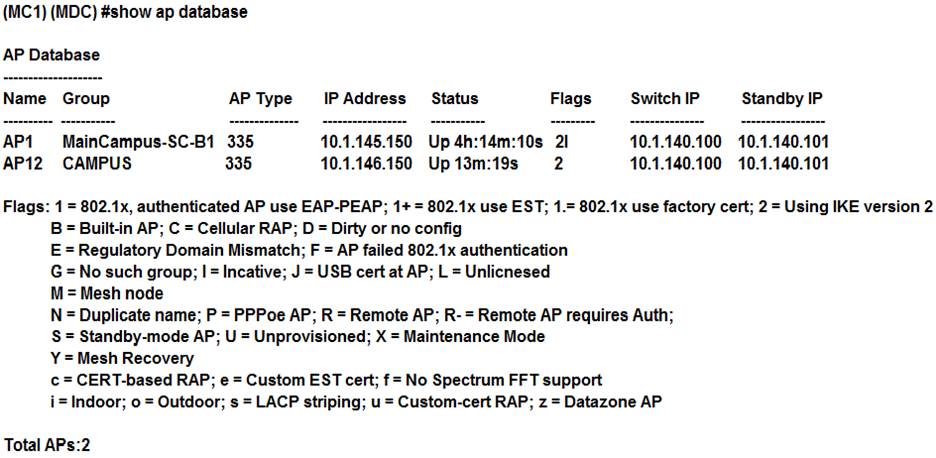
Exhibit 2

Based on outputs shown in the exhibits, what is the reason that AP12 is seen by two different controllers?
- A . AP12 connects to a high availability group. MC1 is the active controller, and MC11 is the standby controller.
- B . AP12 is a multizone AP. MC1 is part of the primary zone, and MC11 is part of the datazone.
- C . AP12 connects to an MC cluster. MC1 is the A-AAC, and MC2 is S-AAC.
- D . AP12 is in the middle of the boot process. MC1 is the master IP controller, and MC11 is the LMS IP
controller.
Refer to the exhibit.
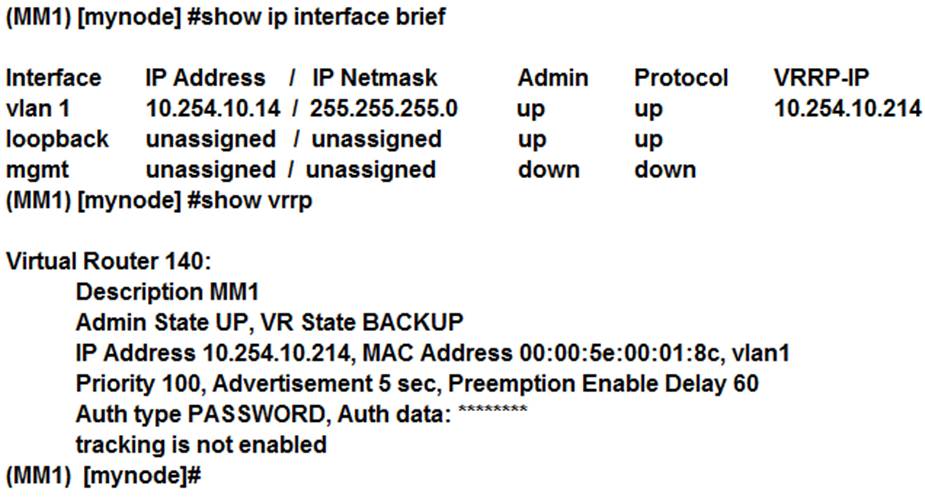
After a recent power outage where MM1 is located, the network administrator could not perform configuration tasks on Mobility Controllers (MC) for several hours. The network administrator decides to acquire another Mobility Master (MM) and deploy L2 MM redundancy. The new MM is assigned the 10.254.10.15 IP address and VRRP is configured in both units. The network administrator verifies that VRRP is running, and prepares to complete the setup with the following scripts.
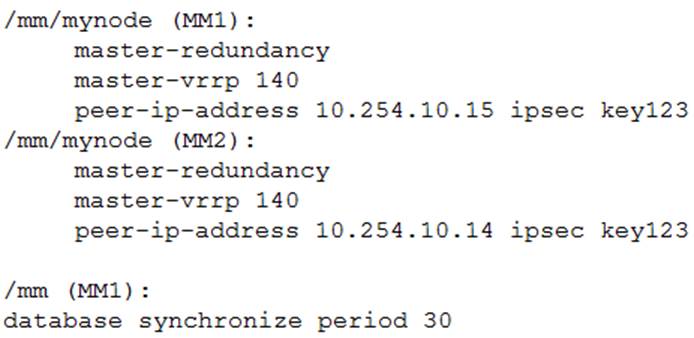
Which configuration tasks must the network administrator do before applying the script in order to successfully deploy L2 MM redundancy and prevent any other control plane outage?
- A . Confirm that the VRRP and master redundancy keys are the same.
- B . Change the VIP address of ther VRRP process 140 to 10.254.10.15.
- C . Reduce the VRRP priority to 90 and restart the process in MM2.
- D . Enable the MM database synchronization in MM2.
Company 1 and Company 2 are medium-sized companies that collaborate in a joint venture. Each company owns a building, and each has their own ArubaOS 8 Mobility Master (MM)-Mobility Controller (MC) deployment. The buildings are located in front of one another. For the initial stage of the project, the companies want to interconnect their networks with fiber, and broadcast each other’s SSIDs.
These are the requirements:
Do not unify the company’s network management responsibilities.
Allow each company to take care of their own SSID setups when broadcasted in the other building.
Terminate Company 1 user traffic on Company 1 MCs when they connect to Company 2 APs.
Terminate Company 2 user traffic on Company 2 MCs when they connect to Company 1 APs.
What is needed to meet the solution requirements?
- A . Multizone APs
- B . Inter MC S2S Ipsec tunnels
- C . Multi MC Clusters
- D . Inter MC GRE tunnels
Refer to the exhibits.
Exhibit 1
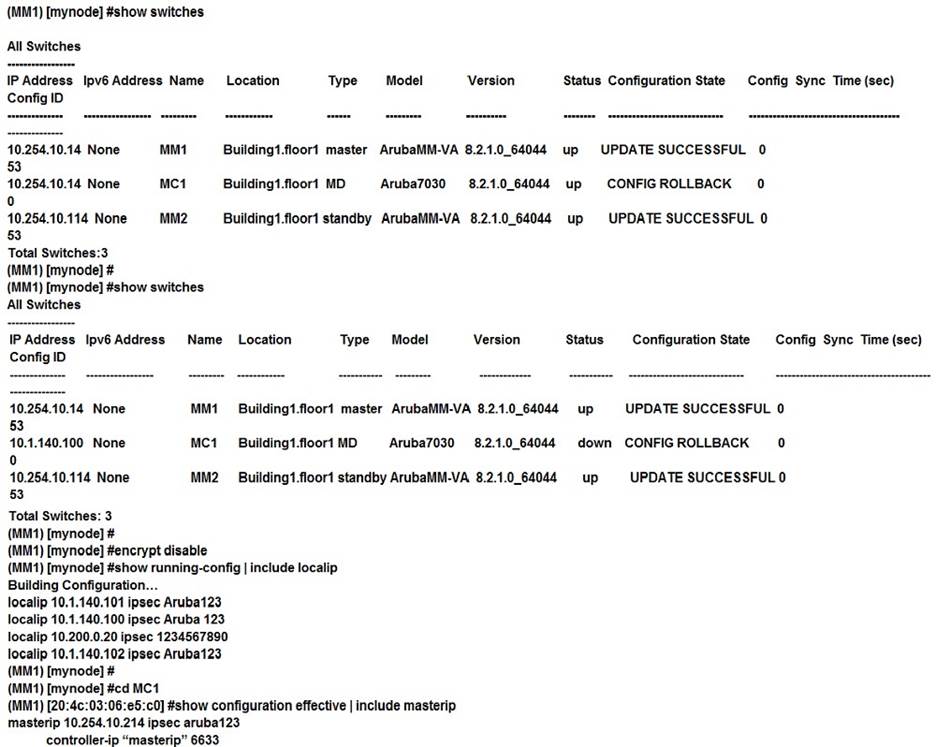
Exhibit 2
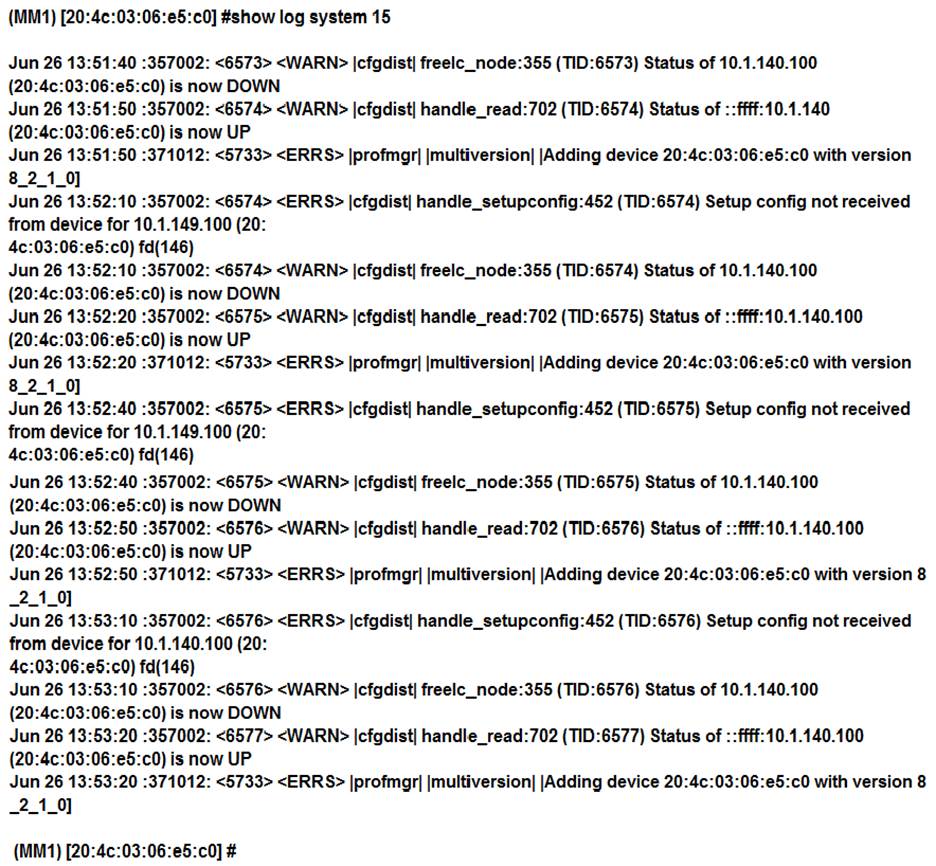
Exhibit 3
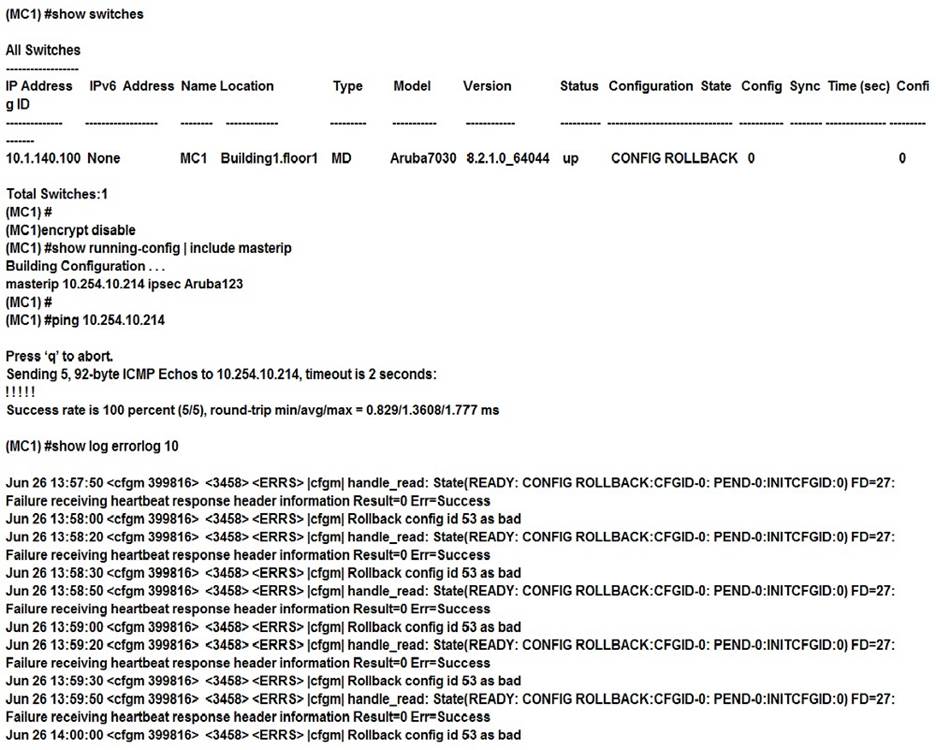
A network administrator deploys a Mobility Master (MM) pair with the VRRP VIP equal to 10.254.10.214, and attempts to associate MC1 to it. At first, the integration appears to be successful.
However after a few minutes the network administrator issues the show switches command and sees that the MC1 is down, even though the device is up and running.
Every time the network administrator reboots the Mobility Controller (MC), the MC shows as being up and then it shows as being down. The network administrator gathers the information shown in the exhibits.
What should the network administrator do to resolve this problem?
- A . Change the localip ipsec key to Aruba123 in the mynode device level from the MM, save, and reboot.
- B . Enable disaster recovery mode in MC1 and change the masterip ipsec key to Aruba 123, save, and reboot.
- C . Change the masterip ipsec key to Aruba123 in the device level from the MM, save, then reboot MC1.
- D . Wipe out the configuration in MC1 and reboot, then run the full-setup configuration dialog all over again.
A network administrator deploys AirWave over a Mobility Master (MM)-Mobility Controller (MC) network to monitor, audit, and report activities. The main areas of concern are with high user density, not enough APs, or not enough channel bandwidth.
Which two report options can the network administrator user to create a weekly report that shows networking equipment with more users and high-demand applications used by top talkers? (Select two.)
- A . Most Utilized Folders by Maximum Concurrent Clients
- B . Most Utilized by Usage
- C . Top Applications Summary
- D . Most Utilized by Maximum Concurrent Clients
- E . Top 3 Applications For Top 10 Users
Several users are connected to the same WLAN and want to play the same multicast-based video stream. The network administrator wants to reduce bandwidth consumption and at the same time increase the transmit rate to a fixed value for WMM marked video streams in a large-scale network. Broadcast Multicast Optimization (BCMCO) is already on.
Which two configuration steps does the network administrator have to perform to optimize the multicast transmissions? (Select two.)
- A . Enable Dynamic Multicast Optimization (DMO) and set forwarding mode to tunnel in the VAP profile.
- B . Enable Broadcast Multicast Rate Optimization (BC/MC RO) in the SSID profile.
- C . Enable Broadcast Multicast Optimization (BCMCO) and set forwarding mode in the VAP.
- D . Disable Broadcast Multicast Optimization (BCMCO) in the VLAN.
- E . Set Video Multicast Rate Optimization (VMRO) in the SSID profile.
Refer to the exhibit.
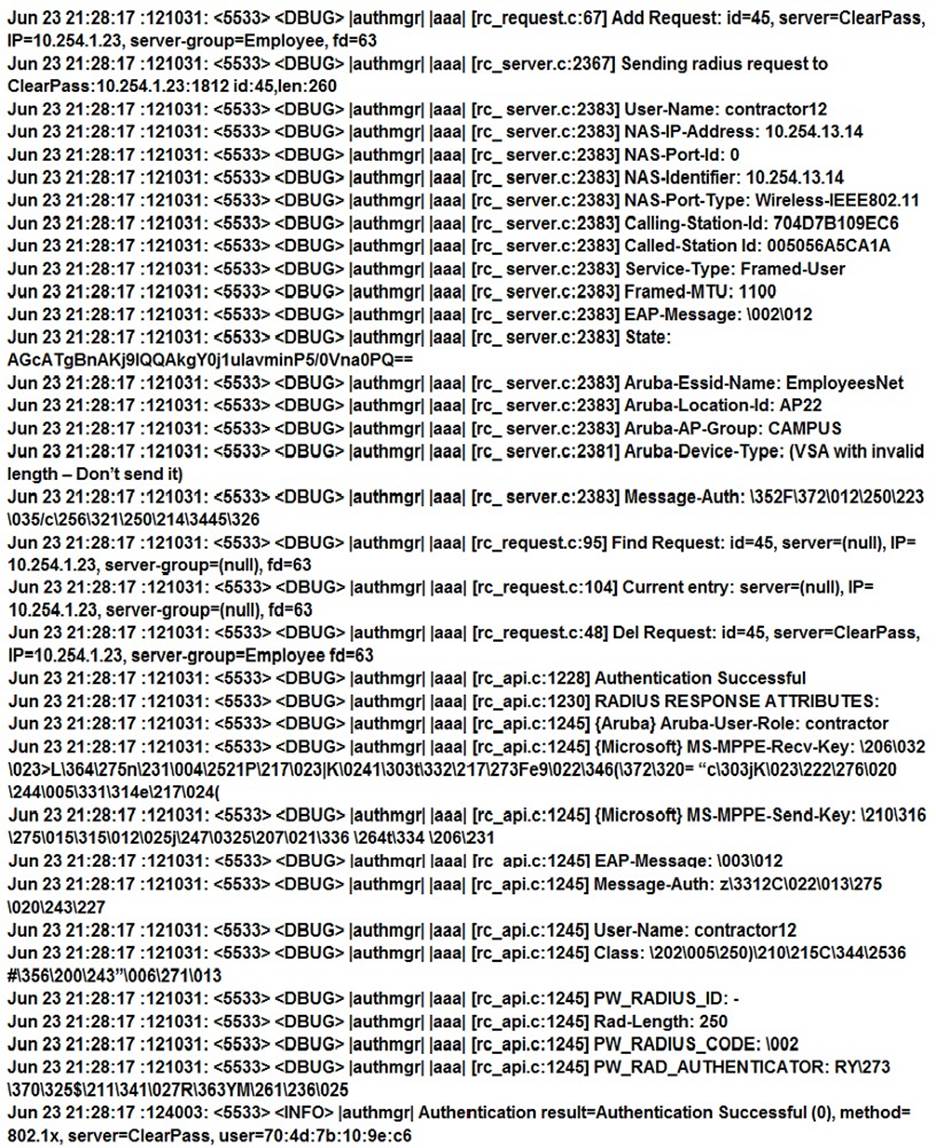
A network administrator wants to allow contractors to access the WLAN named EmployeesNet. In order to restrict network access, the network administrator wants to assign this category of users to the contractor firewall role.
To do this, the network administrator configures ClearPass in a way that it returns the Aruba-User-Role VSA with the contractor value. When testing the solution the network administrator receives the wrong role.
What should the network administrator do to assign the contractor role to contractor users without affecting any other role assignment?
- A . Set contractor as the default role in the AAA profile.
- B . Create the contractor firewall role in the MC.
- C . Create server derivation rules in the server group.
- D . Check the Download role from the CPPM option in the AAA profile.
An organization owns a fully functional multi-controller Aruba network with a Virtual Mobility Master (VMM) in VLAN 20. They have asked a network consultant to deploy a redundant MM on a different server. The solution must offer the lowest convergence time and require no human interaction in case of failure.
The servers host other virtual machines and are connected to different switches that implement ACLs to protect them. The organization grants the network consultant access to the servers only, and appoints a network administrator to assist with the deployment.
What must the network administrator do so the network consultant can successfully deploy the solution? (Select three.)
- A . Reserve one IP address for the second MM and another IP address for its gateway
- B . Configure an ACL entry that permits IP protocol 50, UDP port 500, and multicast IP 224.0.0.18.
- C . Allocate VLAN 20 to the second server, and extend it throughout the switches.
- D . Reserve one IP address for the second MM and another for the VIP.
- E . Configure an ACL entry that permits UDP 500, UDP 4500, and multicast IP 224.0.0.1.
- F . Allocate another VLAN to the second server, and permit routing between them.
Refer to the exhibit.
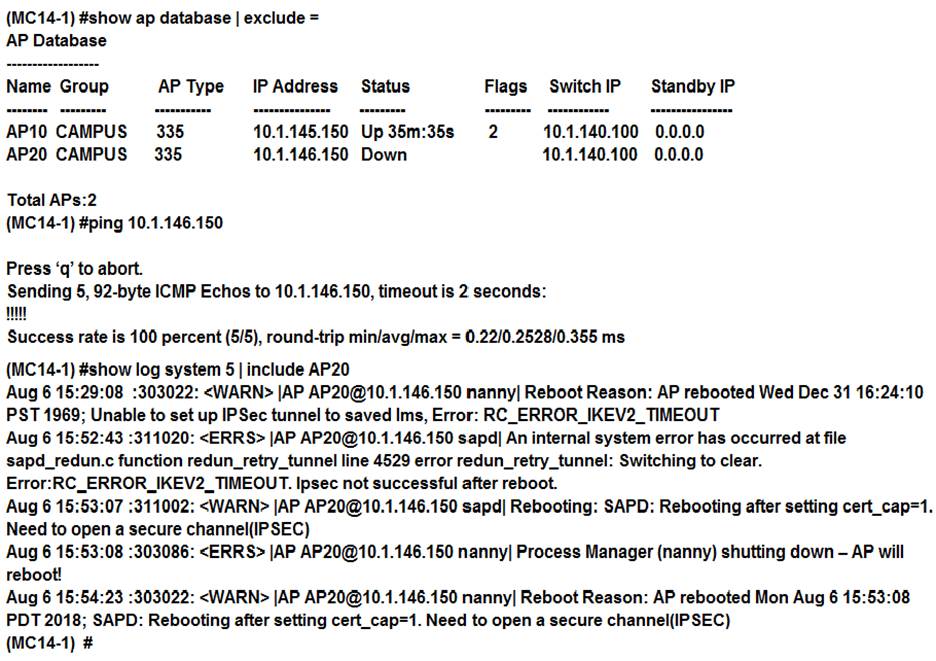
A network administrator deploys a Mobility Master (MM)-Mobility Controller (MC) solution in the headquarters. The network administrator prepares the wired side of the network with the proper VLAN, DHCP settings, and routing services to ensure that APs can reach the MCs.
The network administrator connects two APs in different IP segments and waits for 20 minutes, but SSIDs are advertised in one of the APs only. The engineer logs into the MC console and sees the output shown in the exhibit.
What is the reason that the AP20 is not broadcasting SSIDs?
- A . IPSec traffic is being blocked.
- B . IKE traffic is being dropped.
- C . PAPI traffic is being blocked.
- D . GRE traffic is being blocked.
Latest HPE6-A48 Dumps Valid Version with 61 Q&As
Latest And Valid Q&A | Instant Download | Once Fail, Full Refund

